March 28, 2024 – Volume 26, Issue 3
In This Issue
- Flanigan’s Net Positive: 1.5 Billion Vegetarians
- Ohio’ Solar Milestone
- The 2024 World Happiness Report
- Dancing Away Depression
- Shell Closing 1,000 Gas Stations
- Big Q4 Battery Ramp-Up
- Strongest Ever Auto Pollution Standards
- Electrifying Heavy Duty Trucks
- Environmental Social Governance – ESG
- Flanigan’s Eco-Logic Podcast Updates
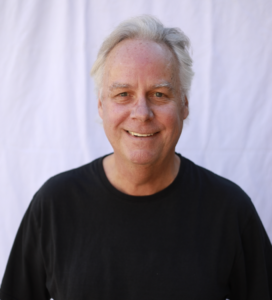
Flanigan’s Net Positive: 1.5 Billion Vegetarians
Some time ago, in 2012 to be a bit more precise, EcoNet reported that there were 7.3 million vegetarians in the United States. We’ve now been updated by our colleague Kane Rosario at the World Animal Foundation. Data from 2023 shows that there are 9.7 million U.S. vegetarians, about 3% of the population. Worldwide, 22% of the Earth’s population, or 1.5 billion people, are vegetarian.

So what is a “vegetarian?” First and foremost, they eat plant-based diets. Michael Pollen’s seven-word diet: “Eat food, not too much, mostly vegetables!” Good advice. There are a wide variety of plant-based, “vegetarian” diets. Meat is always excluded. Consider the variety of types:
- Vegans, eat no animal products such as meat, milk, poultry, cheese, eggs, fish, or honey
- Lacto Vegetarians don’t eat meat, poultry, fish, or eggs but will still use dairy products
- Lacto-Ovo Vegetarians don’t eat meat, fish, poultry, or honey but will consume eggs and dairy products
- Ovo Vegetarians eat eggs but refrain from all other animal products such as meat, milk, fish, poultry, or honey
- Pesco Vegetarians will eat fish but no other sources of meat or dairy
- Pollo Vegetarians consume poultry but refuse red meat consumption

The World Animal Foundation is a digital platform advocating animal rights, responsible pet ownership, and compassionate awareness. It claims that shifting to a vegetarian diet can reduce the amount of land needed for agriculture by 75%. According to the World Cancer Research Fund, vegetarians have 14% less risk of cancer.
Vegetarianism is far from a new thing. Monks and other spiritual leaders have often lived without eating meat or partaking in animal slaughter. Worldwide, many simply cannot afford meat, it’s too expensive or just not available. Due to Tamil and Hindu religious convictions, India has a high share of vegetarians. In addition, its impoverished population can’t afford meat and thus rely on plant-based foods. In India, ~35% of the population is vegetarian. India has a 13% vegan share; China next with 6% vegan share and similar socioeconomic conditions. In America, vegans are a fraction of the U.S. vegetarians… likely less than 1%.

That said, there is an explosion of interest in healthy, plant-based foods in America today. The health benefits are speaking to us. The Vegetarian Resource Group based in Baltimore, Maryland reflects on consumer demand and that Target is selling almond and soy milk, Chipotle has a vegan bowl, and Carl’s Jr is offering Beyond Burgers, all meat-free. While those that consider themselves to be vegetarians is a limited number, many of us have shifted to consuming more and healthier, plant-based foods. Turns out that 46% of Americans always or sometimes eat vegetarian meals when eating out. The power of the increment: This has great value for our bodies and for our society.
Quote of the Month
“It’s fascinating that something as simple as dancing can hold such power over our mental health… Makes you wonder how many other traditional forms of healing we overlook in modern medicine.”
Ohio’ Solar Milestone

Ohio is making solar history. The planned and recently approved Oak Run solar farm, developed by Kansas City-based Savion Energy, a Shell Group subsidiary, will be located on 6,000 acres west of Columbus in Madison County, Ohio. It will be made up of 800 MW solar, 300 MW of battery storage capacity, serviced by two 3.5-mile transmission lines. Oak Run will be the state’s largest solar project, and the largest agrivoltaics project in the country. It was approved by the Ohio Power Siting Board last week.
Fully 90% of Madison County is designated as farmland. Thus the Oak Run project faced considerable local opposition, over 1,000 public comments regarding the project. The project was approved with nearly 50 conditions. A major condition is that Oak Run must graze at least 1,000 sheep and grow crops on 2,000 acres after the first year of operation. Within eight years of operation at least 4,000 acres will be used for agrivoltaics, a blend of solar production and agriculture. That will make it the largest agrivoltaics project in the United States.
Oak Run is the first of its kind… a utility-scale solar farm for solar, livestock, and row crops. Oak Run will create 1,200 construction jobs and will generate $8.2 million in annual revenues for the county, local governments, and schools.
The 2024 World Happiness Report

It’s in… the 2024 edition of the World Happiness Report. It ranks the happiest countries in the world. Some big news: Since the report was first released 12 years ago, this is the first time that the United States is not in the top 20. We are now 23, just behind the United Arab Emirates and Slovenia. Here’s the list:
- Finland
- Denmark
- Iceland
- Sweden
- Israel
- The Netherlands
- Norway
- Luxemburg
- Switzerland
- Australia
- New Zealand
- Costa Rica
- Kuwait
- Austria
- Canada
- Belgium
- Ireland
- Czechia
- Lithuania
- United Kingdom
Observations: First, Nordic countries top the list. Second, there are no countries which have large populations. In the top 10, only Australia and The Netherlands top 15 million people. In the top 20, only Canada and the United Kingdom exceed 30 million people. By age, the United States is ranked in the top 10 by “old people,” those over 60. But for those less than 30 years old, the U.S. scored only 63rd.
Data was drawn from the World Gallup Poll based on responses from over 100,000 people all over the world. The study is rooted in a fundamental question: Participants are asked what step of a ten-step ladder they feel they are on… the highest step representing the “person’s best life.” The editors have identified six factors at the root of happiness:
- Social support is considered the best predictor of happiness. If people feel that they have at least one friend to reach out to in need, they are more likely to feel secure.
- Gross Domestic Product per capita, is a key economic metric of national well-being.
- An expectation of a healthy life, based on the physical and mental health of the population, is a factor.
- The freedom to make life choices also is an underpinning to happiness.
- The degree to which a country and its people are generous, how charitable a country’s people are, is important.
- Inversely, the perception of government and corruption is a downer.
The report is a collaborative effort between Gallup, the Oxford Wellbeing Research Centre, the United Nations Sustainable Development Solutions Networks, and the World Happiness Report editorial board. They report growing worldwide demand for happiness and wellbeing, and recognition of the science of happiness.
Dancing Away Depression

A new study conducted by Australian researchers finds that dancing is the best form of exercise to combat depression, beating out walking, jogging, yoga, tai chi, strength training, and others. The purpose of the study was to identify the best means of combating major depressive disorder, either in tandem or compared to prescription of psychotherapy and antidepressants.
The study was conducted by researchers from the University of Sydney, the University of New South Wales, Macquarie University, and Queensland University of Technology. Published in Sports Medicine, the study is a “large systematic review with meta-analyses investigating the effect of dance on psychological and cognitive health.” The researchers used a variety of “dance interventions” from a broad range of genres of music and dance… theatrical dance, aerobic dance, traditional dance forms, and social dance. And they found that dance is better than other physical activities for a wide variety of age groups and with and without clinical conditions.
Through 218 different studies with 14,170 participants, researchers found moderate reductions were made across the board with exercise. But within that window, dancing was at the top of the charts in terms of the largest reductions in depression symptoms. Women seemed to fare well with strength training, men more affected by yoga and tai chi.
Just as there are many dancing styles from ballet to salsa and ballroom, there are many benefits of the rhythmic movements of dancing: Moderate-intensity dancing improves cardiovascular health, especially hip hop. Dancing increases muscle strength, especially calf muscles in ballet. A study links square dancing with bone density and lower body strength.
For some, depression symptoms are tied to reduced neurotransmitter activity in the brain. Research has extensively tested the body and brain’s response to movement and shown that it can greatly impact one’s overall well-being. Experts note that dancing, like other forms of exercise, releases endorphins that can create a mood boost during and after dancing. I learn about DMT, or Dance Movement Therapy.
Dancing also builds strong bones and it enhances balance, flexibility, and coordination. It boosts brain power, drawing on cognitive skills for set routines. It’s good at stemming off the effects of Alzheimers, and lowers rates of dementia. Overall, dancing is known to lower stress, lift spirits, and keeps you socially connected. It’s physical and mental… a social, heart-pumping activity.
Shell Closing 1,000 Gas Stations

The oil giant Shell is shifting its focus. Its Energy Transition Strategy 2024 report announced that it is planning to close 1,000 gas stations in the next two years. While that’s only 4% of its global network of gas stations, the move signifies a big shift. Shell is shifting its focus to EVs, primarily in Asia and Europe.
Shell reports that today there are 40 million Battery Electric Vehicles and Plug-In Hybrid EVs on the road… with 275 million expected by 2030. “The availability of charging points will be critical for the growth in electric vehicles.” As such, Shell’s EV charging division – Shell Recharge – is now ramping up fast. Its charging station in Shenzhen, China has 258 chargers. It opened in September near the airport in partnership with Chinese EV maker BYD.
At the end of 2023, Shell Recharge was operating 54,000 public charge points worldwide, up from 27,000 in 2022. Shell considers itself to have a competitive advantage in charging… citing its vast global network of service stations with convenience stores to offer customers coffee, food, and other items when they charge their cars.

Shell plans to have installed 70,000 EV charge points by 2025 and 200,000 charge points by 2030. In the United States, Shell completed its purchase of Volta, an EV charging company with a unique media display – and thus source of revenues – with 3,000 charge points across 31 states and many more in development.
Big Q4 Battery Ramp-Up
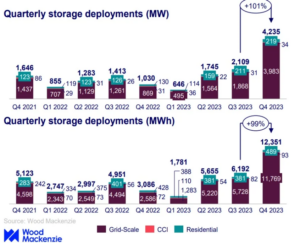
The final quarter of 2023 was remarkable for batteries… a 101% increase from the last quarter, and a whopping 358% increase compared to 3Q 2022. In the final quarter of 2023, there was 4,235 MW/ 12,351 MWh of battery storage installed in the United States. The fourth quarter result was made possible by easing supply chains and system price declines.
According to Wood McKenzie and the American Clean Power Association report, this was the first time that more than 3 GW of storage capacity was installed in a three-month period. In fact, the number topped 4 GW (4.235). California leads the nation with storage, followed by Arizona and Texas.
Of the total battery capacity, the vast majority installed was grid scale. The amount of “behind-the-meter” battery energy storage was 218.5 MW… about 5% of the total installed.
Strongest Ever Auto Pollution Standards
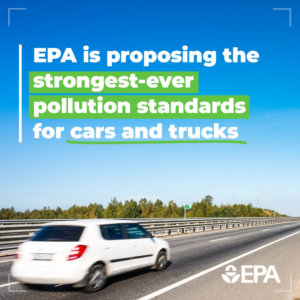
On March 20, 2024, the U.S. EPA issued its final rule: “Multi-Pollutant Emissions Standards for Model Years 2027 – and Later Light-Duty and Medium-Duty Vehicles.” It sets more new and more protective standards to further reduce harmful air pollutant emissions. It builds on the standards set for 2023 – 2026 and leverages advances in clean air technologies to reduce smog, soot, and climate pollution, while saving drivers money through reduced fuel and maintenance costs.
The rule will reduce greenhouse gasses, nitrous oxide, and particulate matter. From 2027 – 2035, the rule will mitigate 7.2 billion metric tons of CO2, while providing $100 billion in net benefit to consumers and society in health benefits and reduced costs.
For light-duty vehicles, the standard is projected to result in an industry-wide average target for the light duty fleet of 85 grams CO2 per mile in 2032. This represents a nearly 50% reduction in the projected fleet average emissions target from the 2026 standard. Cars will drop from 139 grams CO2/mile in 2027 to 73 grams per mile in 2032. Light-duty trucks will drop from 184 to 90 grams in the same five-year period.
LAW360 reports that more than 1 million new electric vehicles were sold in the United States in 2023. EVs now account for about 10% of the overall American light-duty car sales according to the Alliance for Automotive Information. And despite some reports of lower consumer demand for EVs, there are now 111 models of electric vehicles available for sale in the United States.
Some barriers retard even faster EV adoption. EVs are still more expensive according to Kelley Blue Book: EVs sold for an average price of $52,314 in February, 19% higher than the median price of a mainstream, non-luxury vehicle. A big factor is perceived and actual lack of charging. Range is certainly still of concern.
In 2021, President Biden set a goal for 50% of all new cars and trucks sold in the U.S. to be electric or hybrids by 2030. That same year and to support that goal, the Infrastructure Investment and Jobs Act (“bipartisan infrastructure law”) provided billions for EV charging and battery manufacturing. Enhanced tax incentives for EVs were provided in the Inflation Reduction Act of 2022. Then in March, as reported here, the EPA issued its strictest ever tailpipe emissions regulations, deliberately aiming to re-energize the audit industry towards electrification.
Electrifying Heavy Duty Trucks
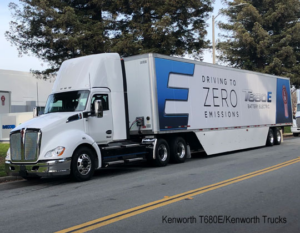
Heavy duty trucks are only 5% of all the vehicles on the road, but represent 25% of vehicular emissions. Thus their electrification has tremendous greenhouse gas implications, matched with a fundamental challenge: While diesel trucks can go ~900 miles on a full tank, an electric semi has a range of only 200 – 300 miles. Therefore, today they are not as well suited for transcontinental jaunts. To enable electric trucks to run our nation’s highways, there would need to be chargers available at least every 100 miles, a system of high-power charging hubs.
The federal government recently released the National Zero Emission Freight Corridor strategy, a 15-year roadmap for developing charging stations and hydrogen fueling stations across the country. The intent is to provide sufficient charging for the more than 20 million cargo vans, box trucks, and short-haul and long-haul semis. The strategy begins with chargers for 30 freight hubs near ports, train depots, and other concentrations of freight traffic. The next phase involves developing corridors with adequate charging. Third, connect the corridors.
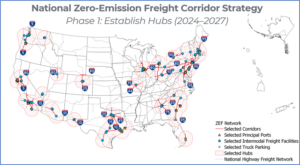
Image Courtesy of the U.S. Department of Energy
EPA’s proposed rule for trucks was released in April of 2023 – officially known as the GHG Emissions Standard for Heavy-Duty Vehicles Phase 3 – aims to reduce emissions from these trucks by 29% below 2021 levels by 2032. It will apply to new trucks beginning in 2027. Since the EPA rule, there have been industry concerns about inadequate electric charging to make the transition feasible. These groups have pushed for an “off-ramp,” a weakening of the standards, if infrastructure deployment targets aren’t met.
In related news, a new report by Energy Innovation finds that electric trucks are closer to being commercially viable than previously thought. Key to the deployment of heavy-duty vehicle (HDV) electric trucks is the cost of their battery packs. A Volvo FH electric prime mover, has a 540 kWh battery pack and a range of 300 kilometers. A Bloomberg New Energy Finance outlook reports on a pivotal shift: Battery electric HDVs are expected to reach price parity with their diesel counterparts sooner than previously anticipated. In a forecast a year ago, Energy Innovation predicted battery costs would be $123/kWh by 2030. Now that same firm predicts $85/kWh by 2030, a 31% reduction, making electric heavy duty trucks that much closer to cost-effective reality.
Environmental Social Governance – ESG
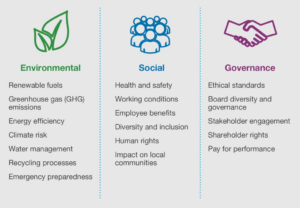
ESG is a management and analysis framework used to understand and measure how sustainably an organization is operating. ESG takes a holistic view that sustainability extends beyond just environmental issues. It also focuses on social and governance factors.
The ESG lens helps assess how an organization manages the risks and opportunities created by changing conditions, such as shifts in environmental, economic, and social systems. It has changed the way some capital decisions are made by many of the largest financial services and asset management firms in the world. There are ESG rating agencies that assign ESG scores that range from 0 – 100. Generally, poor performance is reflected in a score of less than 50; excellent performance would result in a score of more than 70.
Environmental factors considered include direct and indirect greenhouse gas emissions, stewardship of natural resources, and overall resilience against climate calamities such as flooding and fires. Social factors focus on human capital management and metrics such as fair wages and impacts on communities in which the organization operates. Social factors extend up the supply chain… particularly in developing economies where environmental and labor standards may be less robust. Governance focuses on how an organization is led and managed, if its leadership incentives are aligned with shareholder rights, whether it has internal controls to promote transparency and accountability.
ESG has evolved from movements that focused on health and safety issues, pollution reduction, and corporate philanthropy. In the 1980s, it was “EHS” Environmental Health and Safety, then Corporate Sustainability in the 1990s, followed by “CSR” or Corporate Social Responsibility in the early 2000s. ESG was first mentioned in a 2004 United Nations report. In the 2010 – 2020 timeframe, ESG emerged as a strong force. It went mainstream when the framework and its scores became an integral part of many institutional investors’ playbooks.
Flanigan’s Ego-Logic Podcast Updates
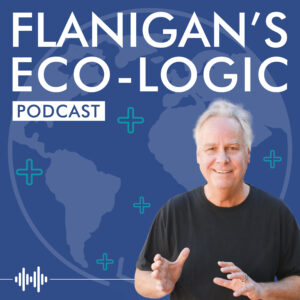
Use the links below to check out our recent podcasts. And you can always go to Spotify and type in “Ted Flanigan” to find our library of podcasts.
Big News:
Feedspot has listed Flanigan’s Eco-Logic as one of the Top 15 Sustainability Podcasts in California. Feedspot is a platform that lets users access their favorite blogs, podcasts, news websites, Youtube channel, and RSS feeds in one place. EcoMotion has now produced over 150 podcasts that tell powerful stories in crafting sustainability. We’ve had great guests, I thank them. I also thank our podcast coach, Rhys Waters, and Alizeh Siddiqui and Sierra Flanigan without whom there would be no podcast.
Recently Released:
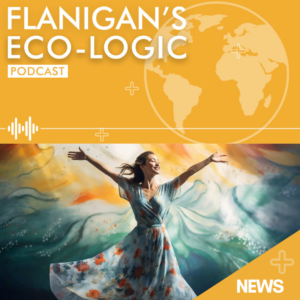
EcoNet News, Volume 26, Issue #3, highlights data from 2023 showing that there are 1.5 billion people worldwide that are vegetarians. He goes on to highlight Ohio’ solar milestone, the 2024 World Happiness Report, a new study that finds dancing to be the best form of exercise to combat depression, Shell closing 1,000 gas stations, the final quarter of 2023 ramping up battery storage, the strongest ever auto pollution standards issued by the U.S. EPA, electrifying heavy duty trucks, and Environmental Social Governance (ESG). Ted also shares big news: Feedstock has listed Flanigan’s Eco-Logic as one of the Top 15 Sustainability Podcasts in California!
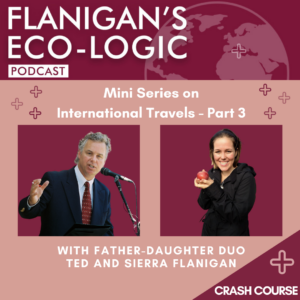
In this episode of Flanigan’s Eco-Logic, father-daughter duo, Ted and Sierra Flanigan conclude the clean energy crash course mini series focusing on Ted’s international travels. Part 3 focuses on Ted’s work and tours in the Philippines, Sweden, Germany, Spain, and concluding with Iceland. They dive into the context for each trip, and discuss lessons learned.
Ted begins with his work in the Philippines as part of the Efficient Lighting Initiative to accelerate transitions to more efficient lighting in developing countries. He then hops over to Sweden for four consecutive summers with The Energy Coalition. The purpose of these trips were exchanges with utility and city officials from California, notably from Irvine and Santa Monica, and vice versa, as well as with students through the PEAK program.
Sierra then asks Ted about his solar tours in Germany and Spain. He starts with Germany, unpacking the reason why Germany is seen as a global leader in solar, and sharing the story of the most lucrative feed-in tariff (FIT) ever implemented. He then moves on to Spain, highlighting the difference with their FIT program, which was not quite as rich, but really moving the market at the time.
They conclude with the tour of Iceland’s geothermal facility, and Ted shares how impressed he was by the sheer amount of geothermal energy and electricity as a result, that the country started converting cars to hydrogen fuel with the excess to decarbonize their transportation sector. Ted and Sierra wrap the three-part series, highlighting how rich the world is with renewables, and how much can be learned when traveling with a mission and broadening horizons.
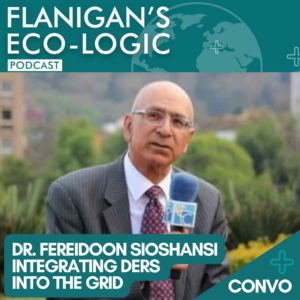
In this episode of Flanigan’s Eco-Logic, Ted speaks with Dr. Fereidoon P. Sioshansi, President of Menlo Energy Economics, a consulting firm based in San Francisco, California. With over 35 years of experience in the electric power sector, he advises clients on strategies to respond to the rapid transformation of the energy sector, including utilities, energy intensive industry, innovators, start-ups and companies engaged in the electricity delivery supply chain, and regulators and policy makers.
He is also a prolific author in the energy space, and the editor and publisher of EEnergy Informer, a monthly newsletter with international circulation, now in its 29th year of continuous publication.
He and Ted discuss his decades of experience, working in more than 3 dozen countries, covering all aspects of the electricity power sector. They reminisce on their Demand Side Management (DSM) works at EPRI, and discuss the transformation, new framework, and structuring within the utility industry, specifically integrating distributed energy resources into the grid. They also highlight his newsletter and 15 books, including his 16th, forthcoming book on electrification, stating that the way to climate salvation is to electrify everything and anything that we possibly can.
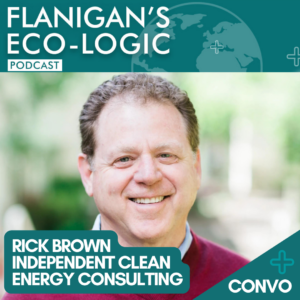
In this episode of Flanigan’s Eco-Logic, Ted speaks with Dr. Rick Brown, Founder and Chairman of the Board at TerraVerde Energy, an extraordinarily accomplished independent clean energy consulting firm representing school districts, public agencies, and commercial enterprises. TerraVerde supports their clients with the design and deployment of clean energy projects and programs that reduce costs, increase resiliency, and enhance sustainability.
Dr. Brown founded TerraVerde in 2009 and served as CEO through December 2019. Since TerraVerde’s founding, the consulting firm has supported the successful implementation of close to $650 million worth of distributed solar PV and battery energy storage systems for which they have provided independent technical and financial feasibility analyses, project development support, project implementation management, and continue to provide ongoing asset management services for a portfolio of nearly 400 solar and battery energy storage systems.
Since retiring as CEO, Dr. Brown has spent a lot of time on advocacy work, through a number of different venues. He continues to work on the State’s solar policy, specifically net energy metering, and market and capital innovations in support of decarbonizing and increasing the resilience of the energy and building sectors.
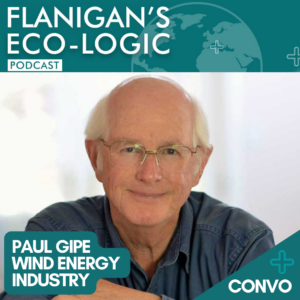
In this episode of Flanigan’s Eco-Logic, Ted speaks with Paul Gipe, an author, advocate, and analyst of the renewable energy industry. Paul is a world renowned wind power expert, and has written extensively about the subject for the past four decades, receiving numerous awards for his efforts.
Gipe has lectured before groups from Patagonia to Puglia, from Tasmania to Toronto, and from Halifax to Husum. He has spoken to audiences as large as 10,000 and as small as a private presentation for Vice President Al Gore. He is also passionate about electric vehicles and writes about his experience driving EVs.
Through his website, Gipe is well known for his frank appraisal of the promise and pitfalls of wind energy, including his stinging critiques of internet wonders and the hustlers and charlatans who promote them. His most recent book, Wind Energy for the Rest of Us, is Gipe’s seventh book on wind energy. In it, he debunks novel wind turbines, rebukes revisionist historians, and argues that renewable energy is too important to be left to electric utilities.
He and Ted discuss the wind energy industry at large, highlighting technological advancements in design, commercial vs. residential uses, offshore “floaters” vs. on land turbines, and solar vs. wind cost efficiency. They also share their love for driving EVs.
